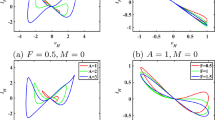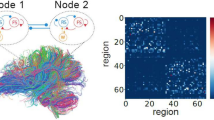Abstract
In this paper we show that during the retrieval process in a binary symmetric Hebb neural network, spatially localized states can be observed when the connectivity of the network is distance-dependent and a constraint on the activity of the network is imposed, which forces different levels of activity in the retrieval and learning states. This asymmetry in the activity during retrieval and learning is found to be a sufficient condition to observe spatially localized retrieval states. The result is confirmed analytically and by simulation.
Similar content being viewed by others
References
Y. Roudi and A. Treves: “An associate network with spatially organized connectivity”, JSTAT, Vol. 1, (2004), P07010.
K. Koroutchev and E. Korutcheva: Spatial asymmetric retrieval states in symmetric Hebb network with uniform connectivity, Preprint ICTP, Trieste, Italy, IC/2004/91, (2004), pp. 1–12.
A. Anishchenko, E. Bienenstock and A. Treves: Autoassociative Memory Retrieval and Spontaneous Activity Bumps in Small-World Networks of Integrate-and-Fire Neurons, Los Alamos, 2005, http://xxx.lanl.gov/abs/q-bio.NC/0502003.
J. Rubin and A. Bose: “Localized activity in excitatory neuronal networks”, Network: Comput. Neural Syst., Vol. 15, (2004), pp. 133–158.
N. Brunel: “Dynamics and plasticity of stimulus-selective persistent activity in cortical network models”, Cereb. Cortex, Vol. 13, (2003), pp. 1151–1161.
J. Hertz, A. Krogh and R.G. Palmer: Introduction to the theory of neural computation, Perseus Publishing Group, Santa Fe, 1991.
M. Tsodyks and M. Feigel’man: “Enhanced storage capacity in neural networks with low activity level”, Europhys. Lett., Vol. 6, (1988), pp. 101–105.
D. Amit, H. Gutfreund and H. Sompolinsky: “Statistical mechanics of neural networks near saturation”, Ann. Phys., Vol. 173, (1987), pp. 30–67.
J. Hopfield: “Neural networks and physical systems with emergent collective computational abilities”, Proc. Natl. Acad. Sci. USA, Vol. 79, (1982), pp. 2554–2558.
D. Hebb: The Organization of Behavior: A Neurophysiological Theory, Wiley, New York, 1949.
N.N. Bogolyubov: Physica (Suppl.), Vol. 26, (1960), pp. 1.
M. Mézard, G. Parisi and M.-A. Virasoro: Spin-glass theory and beyond, World Scientific, Singapore, 1987.
A. Canning and E. Gardner: “Partially connected models of neural networks”, J. Phys. A: Math. Gen., Vol. 21, (1988), pp. 3275–3284.
K. Koroutchev and E. Korutcheva: in preparation.
Author information
Authors and Affiliations
About this article
Cite this article
Koroutchev, K., Korutcheva, E. Conditions for the emergence of spatially asymmetric retrieval states in an attractor neural network. centr.eur.j.phys. 3, 409–419 (2005). https://doi.org/10.2478/BF02475647
Received:
Accepted:
Issue Date:
DOI: https://doi.org/10.2478/BF02475647




